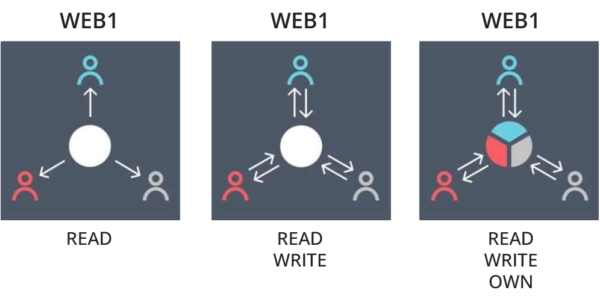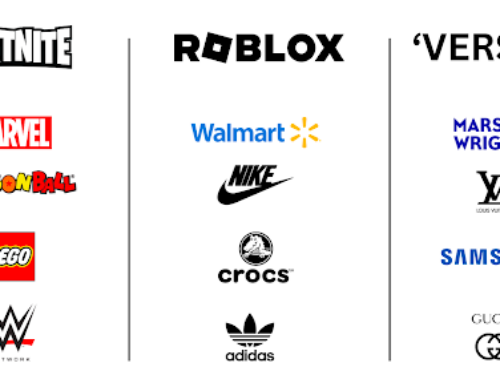What Is (and Isn’t) The Metaverse?
While XR and Web3 comprise the building blocks of what’s known as the metaverse, that doesn’t paint a full picture of what the metaverse actually is. Much like the web in the early 90s, or social media in the late 2000s, it’s still a new concept, even for those of us actively working on it.
But with the potential to reshape our social and economic lives over the coming decade, it’s important that we all know what the metaverse actually is… and what it isn’t. Let’s separate truth and myths about the metaverse.
1. The metaverse is not VR (but VR does make it possible)

First things first – the metaverse ≠ VR, or vice versa.
At the simplest level, virtual reality in the metaverse is the technology that grants users access to a persistent virtual world that still exists and is accessible even after they’ve logged off. It’s not quite the same as a VR game, like BeatSaber – that world ceases to be when you turn off the program. VR software needs that extra layer of permanence and network accessibility to be considered part of the metaverse.
Likewise, the metaverse, while certainly built on top of VR technology, doesn’t necessarily require you to have a VR headset to access it. Elements of what the metaverse makes possible can be drawn into our reality. Augmented and mixed reality can put a layer of the metaverse over everyday objects that can be utilized by a typical smart device – AR-mapped content and MR-powered virtual product recreations are just a few examples.
So no, VR isn’t the metaverse, but it is one of the powerful tools that makes it possible.
2. The metaverse is not Web3 (but it is the future of the Internet)

Likewise, the metaverse is not just another name for Web3. It may be easier to think of it compared to the previous iterations of the web. Web1 wasn’t just a web browser or a search engine, but the technology that allowed them to exist. Web2 was the fountainhead for social media, but is much more than just social media.

Web3’s decentralized transactional nature is an interface that the metaverse is built on top of, to allow for an economy that exists in cyberspace. It protects information and ideas and brings monetary value to digital items and real estate that, without Web3, would just be files to be copied. Ideally, those items won’t be locked to one site or store either. Instead they should traverse across the metaverse as easily as the clothes on your back follow you from home to work.
As we start to spend more time in virtual spaces, the idea of owning a virtual item will shift from novel to mundane. We’re in the early stages of figuring out what that should look like now, but someday, you won’t be able to imagine an Internet without it.
To that point:
3. The metaverse is not owned by any one entity

Despite what Mark Zuckerberg might have you believe, Facebook – or Meta – doesn’t “own” the metaverse. That’s because no one does. It’s more like a wide-open frontier of new land that was just discovered, and people are setting out to stake their claims.
It’s the same principle as the Internet; no one really owns it, but rather, it is the sum of the many connections between web domains. Much like a URL, an entity can own a space in the metaverse, and even rent that space out to others. But in a vacuum, they’re all just digital spaces – it’s the connectivity between them that makes the metaverse itself.
4. The metaverse is a place, and isn’t

The difference between the Internet and the metaverse, however, is that the Internet isn’t a place, really; it’s a network of information. Meanwhile, thanks to immersive XR technology, the metaverse is that too, but can also be a place, in a sense. Even though it exists outside of physical space, it also can be explored like a location in the real world. Space that you can occupy.
We’ll have more to share soon, but our virtual retail space, TheMall, is an example of this. At 100 stories, with 1 million square feet per floor, TheMall is bigger than any real mall that could realistically be built under the constraints of real-world economics or physics. But because it exists in the metaverse, those constraints are lifted, allowing for a much larger and more mesmerizing shopping experience than you could ever hope to have IRL.
On the other hand, the metaverse also isn’t a place, if you consider the other ways it can be accessed. Many of us brought an aspect of the metaverse into our homes during the pandemic when Zoom meetings kept us working and connected to our distant loved ones. So maybe the best way to put it is, even though it can be explored like one, the metaverse isn’t just a place. It’s a medium; a reimagining of how we interact with technology, and with each other.
5. The metaverse is a shift in how we interact with technology

The metaverse, if it can truly come to fruition, will naturally come with a change in how we use not just the tech that makes it possible, but possibly all technology.
Innovation – real innovation – is transformative and violent to the progress that came before it. Think of the phone in your pocket; calling it a “phone” is practically an anachronism, a “skeuonym.” Because it’s not just a telephone, is it? It’s also a web browser, an email client, a television, and a video game console. It takes photos and videos, creates art and music, tells time, and even predicts the weather. One device small enough to fit in our pockets can replace dozens of our previous devices, if not hundreds or thousands.
The metaverse could be just as disruptive. With eye tracking, haptics technology, and AI all progressing quickly, the touch screen may soon go the way of the button, and the rotary dialer before them. Our math teachers were wrong when they predicted we wouldn’t always have a calculator at hand – who knows what the metaverse will make obsolete in 50 years that seems like common sense today?
6. The metaverse is a shift in how we interact with each other

It’s not just the gizmos we use to access the metaverse that might change, but our interactions with each other.
The Internet has undoubtedly brought people closer to each other around the world. Family can stay connected even when they’ve moved halfway around the world, and people can make friends with others from countries they’ve never even set foot in, thanks to the social media platforms Web2 made possible.
But it’s hard to say that technology has brought us all together, either. As connected as we are, we’re a lot more isolated at the same time. We access each other through text and screens but miss out on more tactile experiences that are fundamental to human connections.
Where Web2’s social media grew our connections, Web3 and the metaverse may be able to make those connections feel more real. Haptics technology is already working on bringing the sense of touch to the metaverse, which would bring the much-missed handshake back to the business meeting, and a warm hug back to virtual family reunions.
7. The metaverse is far from settled… and we all have a stake in it

Of course, the kind of cyberspace we’re describing can hardly come about overnight. The metaverse is something of a big ask.
The fact that no one owns the metaverse makes unifying all its elements in a seamless way a major challenge. While groups like the Metaverse Standards Forum are making headway on getting major enterprises to align on shared spaces and assets, there’s a lot of work ahead.
We hope you’ll join us as we help drive these efforts forward.





